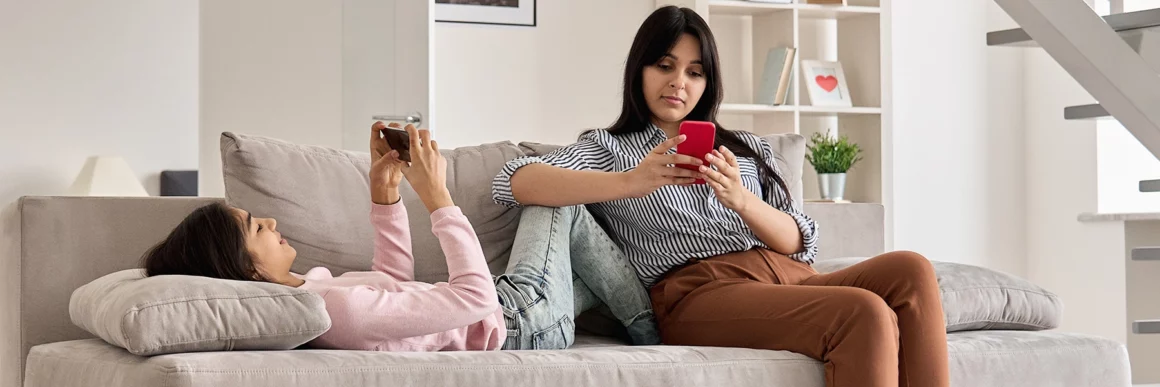Manage screen time and build healthy relationships with tech with these six tips.
Our reliance on digital devices increases every year. In fact, a 2020 report conducted by the American Association of Child & Adolescent Psychiatry – Political Action Committee found that, on average, children ages 8-12 spend 4-6 hours daily using screens, and teens spend up to 9 hours. . That’s a substantial amount, and there are many who suspect we will screen time numbers increase after the onset of the COVID pandemic.
Though screen time might be unavoidable for homework and everyday life, too much screen time can lead to lower grades, mood problems, poor self-image, weight issues, not enough outdoor time, increased cravings, impaired cognitive functioning, and more.
So, since screens are virtually unavoidable, what can we, as caregivers, do to help manage and monitor our tween or teen’s screen time?
6 Tips for Managing Tween and Teen Screen Time
Here are some suggestions:
1. Recognize That Not All Screen Time Is Equal
We can engage in activities that are pure consumption, such as watching TV, YouTube, TikTok, playing video games, or scrolling social media. And we can engage in activities that involve creation, like writing stories, making art, talking over FaceTime, and exchanging emails. Both have value and are enjoyable, but when we access the creative, generative parts of our brains, some of the negative side-effects of screen usage can decrease.
So, rather than judging your young person’s screen usage uniformly across the board, ask them what they are doing, and encourage them to use their devices to connect to other people and their own creative impulses.

2. Protect Your Tween or Teen’s Sleep
The American Academy of Pediatrics recommends that phones not be permitted in the bedroom, and while that may be ideal, it may be more realistic to start by limiting screens at bedtime and while sleeping.
Why? Because numerous studies show a correlation between phones in the bedroom and inadequate sleep quantity, poor sleep quality, and excessive daytime sleepiness. Moreover, research shows that of those teens who reported having a phone in their bedrooms, a full 36 percent reported waking up at night to check their phones at least once.
To help your young person sleep, check in each evening, ideally at least one hour before lights out to check if they need to be on their phone or screens. When they are younger, consider removing screens entirely before bedtime to help them develop better screen habits.
3. Involve Them In Screen Time Discussions
Discuss screen time with them, and help evaluate their own screen usage. Preteens and teens are often more aware than we give them credit for, and may even have concerns about their own tech usage.
Whether they do or don’t, helping them understand what their caregivers believe to be appropriate, healthy, and reasonable can help them monitor their own usage. They can also use tech to help them get a really clear idea about their own usage.
4. Create Time for Offline Connection
- Consider finding regular times where screens are, by rule, put away.
- Eat family meals without any devices on or playing in the background.
- Ask kids to put their phones down in the car and invite them into conversation instead.
- Evaluate the family activity level during the day. Is there too much downtime that allows for screens to fill in for boredom? Set some guidelines around how they fill their time (read a book, maybe) and look to plan family activities such as baking/cooking competitions or game nights, that will distract everyone from picking up their devices.
- Designate several evenings a week as “screen-free.” Or go even further and set screens aside one day a week, as Tiffany Shlain, the author of 24/6: The Power of Unplugging One Day a Week advocates. When you create time for connection, it not only diminishes their overall time on screens, but builds stronger family bonds.

5. Evaluate Your Own Screen Usage
- Are you present when you are with your young people or partner, or are you modeling poor screen usage?
- Do you use the screen time monitors available on your smart devices and have you enabled app limits for your most-used platforms? Do you make an effort to limit your own screen time?
- Do you practice good social graces when you are out and about? Do you put your phone away when you are dining or spending time with a friend?
- How do you spend your free time when you are not working or caring for your family? Are screens your primary form of entertainment, or do you do other things like read, get outside, move your body, and engage your creative side?
- If you could change one thing about your own screen usage, what would it be?
6. Use Tech Tools to Help Lower Screen Time
Set agreed-upon limits to the usage of various apps, and screens altogether. You can do this directly through the screen time settings on your phone or within the Family Link App for iPhone, Android, or Chromebook.
